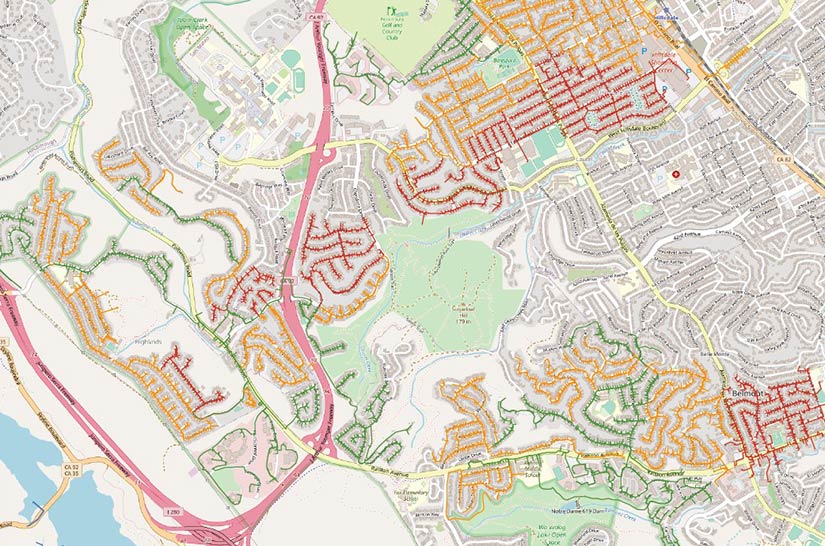NREL and IREC Identify Best Practices for Validating Hosting Capacity Analyses
Procedural and Technical Practices Produce Trusted, Transparent Results To Support Distributed Energy Resource Planning

The electric distribution grid is changing at a rapid rate, with distributed energy resources (DERs) such as rooftop solar arrays, energy storage, and electric vehicles arriving on the grid in fast-growing numbers. However, it is not always clear how much additional DER capacity a community's grid can accommodate.
Conducting a hosting capacity analysis (HCA) can provide much-needed clarity—provided the analysis is based on accurate and validated data. To help improve HCA data and address common challenges encountered in previous analyses, the National Renewable Energy Laboratory (NREL) and the Interstate Renewable Energy Council (IREC) have released a suite of best practices for HCA data validation.
Utilities and regulators use the HCA process to determine the available capacity for new DERs in a given location without requiring expensive grid upgrades and time-consuming interconnection studies. The analysis provides a snapshot of a distribution grid's current ability to interconnect new DERs and often results in a more detailed and accessible HCA map depicting where new capacity is possible.
The new NREL and IREC report identifies best practices for utilities to develop or refine their HCA data validation procedures, aids regulators in their oversight of utilities' HCA data validation practices, and helps other stakeholders evaluate the effectiveness of HCA data.
"Validated hosting capacity data is important for utilities, regulators, and customers, who need accurate, accessible, and trustworthy information to guide strategic DER investments in their communities," said Yochi Zakai, co-author of the report and an attorney at Shute, Mihaly & Weinberger LLP representing IREC.
Building on Past Research To Identify Improved Practices
IREC has been involved in regulatory proceedings and research projects related to HCA development around the country. IREC's HCA webpage provides substantial background and resources on the topic, including a recent report, "Key Decisions for Hosting Capacity Analyses." To build on this work, IREC and NREL joined together to identify best practices for HCA data validation, relying on NREL technical expertise in power flow simulation and feedback from stakeholders that used the first published HCAs.
For the report, NREL and IREC interviewed stakeholders across the electric sector and reviewed early HCA examples for common pain points. From their findings, the research team summarized procedural and technical practices to improve the accuracy of HCA results by incorporating data validation procedures in multiple steps throughout the process. Such practices include business processes like appointing a dedicated HCA manager and establishing and tracking metrics to assess the quality of HCA data and results.
The report also outlines technical best practices around feeder model development, which is often the most challenging, error-prone stage of any HCA. The team identified repeatable and streamlined processes to detect and correct model input errors. The full report includes tables with specific examples of validation procedures for each step in the feeder model building process.
"Our team also identified ways to standardize and document the steps in the process to improve efficiency and accuracy," said Adarsh Nagarajan, a group manager in NREL's Grid Planning and Analysis Center and co-author of the report. "For example, feeders that experience similar challenges can be batched so that engineers can easily develop solutions to common problems."
More Transparency Means More Accurate Data To Support DER Deployment
A recurring recommendation of the report is that HCA quality would benefit from transparency—for regulators to assess any problems and for the public to catch errors and provide feedback. According to the report, transparency maximizes efficiency by allowing customers and data users to regularly share their experiences and errors with the utility. Likewise, utilities and regulators comparing their procedures can more quickly arrive at industry best practices.
These best practices can considerably improve the HCA process for utilities, regulators, and DER permit applicants. By placing early attention on data validation, utilities can avoid later data cleanup and prevent common errors from appearing in the first place. Furthermore, a trusted HCA can streamline DER interconnection, as applicants will have unambiguous information when proposing a new project.
Learn More During May 10 Webinar
As more states and utilities adopt HCA as a means to streamline DER growth, this report offers a reservoir of advice for ensuring HCA data is accurate and trustworthy. To learn more about findings from the report directly from the NREL and IREC team, register for an NREL-hosted webinar on Tuesday, May 10, from 10:00 a.m. to 11:00 a.m. MT.
Last Updated May 28, 2025
